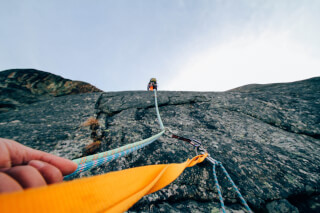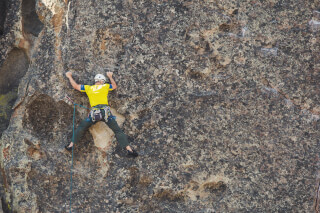Table of Contents

I miss climbing
While I am channelling all this new found time to write and to keep the brain working, I miss being on the wall, working projects, or practicing certain aspects like climb until you fall. Climbing helps to have a distraction especially when the news over the coronavirus pandemic can cause despair. We also have every intention of incorporating climbing into our sailing life, and it features later this year in our 2020 sailing plan.
A few days ago, Ian from SenderOne called. It was unexpected. He and others from the climbing gym were reaching out to the community to see how we were holding up. It was a thoughtful gesture and also emblematic of the climbing community. We watch out for each other.
Earlier yesterday, Andrew and I were discussing the similarities between the two sports/lifestyles. While I will not go though an exhaustive compare and contrast exercise, I will point out a couple highlights.

Redpoint in Climbing
We use the term redpoint in sport climbing to indicate a project route, after a failed on-sight or flash. After climbing for a couple years, I can on-sight 5.11a consistently, 5.11b mostly and 5.11c on occasion. These grades are based on the YDS.
We would project 5.11b and 5.11c routes during our weekend sessions at SenderOne. Typically, when Andrew and I climb, we switch off at the base of each route. I usually go first and he’ll watch me and see my beta. When we want to work on endurance, then we’ll do sets of 2-3 routes at a time and I will watch his beta when he goes first.
Redpoint in Sailing
If I were to translate this approach to sailing, I would say sailing a Catalina 36 would be a 5.11a for me. She is a masthead sloop featuring a fin keel with spade rudder. Her LOA 35.58 feet and beam of 11.92 feet, and she has a displacement of 15,000 lbs. Once I get back on the water on a consistent basis, I would have a short acclimation period, but I could handle this size boat.
Now take s/v Rachel J. Slocum. Before I even put a route rating on her, let’s compare the stats.
- She is a staysail schooner which means 2 masts instead of 1 mast and 5 sails instead of 2 sails. That’s a lot more complexity in sail configuration to begin with.
- RJ Slocum has a sail area of 1,090 sq ft not including staysail or fisherman (versus 555 for Catalina 36).
- She has a wing keel designed by David Pedrick from America’s cup, which lowers her center of momentum and the wing design allows her to foil so she goes fast and tracks well in any point of sail. The Catalina’s fin keel with spade rudder makes her faster and easier to turn than a full keel, but she tends to slam in heavy seas. She is better suited for lighter winds and inshore racing.
- RJ Slocum has LOA 47’4” (or 50’ with stern pulpit) and a beam of 13’ 4”, and she has a displacement of 30,000 lbs empty, 44,000 lbs loaded.
When you add all these elements up, you can imagine why I would be intimidated. I liken her to a 5.14+, a very difficult and technical level for expert climbers. When I described this analogy to Andrew, he said that RJ Slocum is probably a 5.11a outdoor sport route.
I’m not so sure.
Climb until you fall
This intimidation factor in sailing can be mitigated by using some of the techniques learned in climbing, i.e., overcoming mental hurdles, practicing/projecting a route, and visualization. One of the toughest mental hurdles climbers face when they begin the sport is fear of falling.
From time to time, Andrew and I practice falling at the gym. It’s a safer proposition than practicing outdoors given secured bolts and not having to deal with placing protection as you would for trad climbing.
Once we are comfortable falling, we can then put ourselves into a particular mindset, which I call “balls out climbing.”
Balls out climbing
- Climb without reservation
- Keep going to the next hold
- Ignore the pump
- Give every last ounce of strength and go for it
This is what pro climbers do, and you’ll witness it time and again in IFSC world cup competitions. Watching the latest lead climbing comp is a favorite past time of ours.
When you do this type of climbing, it is only then that you will know how much you are capable of. Rather than banking on a percentage in reserve (muscle strength or mental strength), you are testing yourself to see what is possible. Sometimes you’ll surprise even yourself.
Here’s a video of Tommy Caldwell working Pitch 15 of the Dawn Wall, arguably one of the toughest sequence of moves on whisper thin finger and toe holds.
Tension on!
If you have the inclination and time, check out The Push by Tommy Caldwell. In his memoir, he describes the years of effort, preparation and rehearsing moves to send each of the pitches of the Dawn Wall. As a novice climber, I can appreciate and learn from this level of dedication, especially when I approach a new project.
When I’m working a route and I am getting to the crux (i.e., the toughest move or the hardest sequence of moves on a route), I usually call out, “Take!” to my belayer, Andrew. More often than not, I need to breathe into my muscles, reduce the lactic acid build-up, evaluate the sequence of moves, and mentally prepare myself to work through it.
The fact is, this happens more often than not. As a result, it becomes a crutch, even if it’s a route that is within my capabilities. When you leave something in reserve, you may as well give yourself an excuse to fail. Mentally, you tell yourself, “I could have sent the route if I had just given it 100%.”
The real question is, “How do you really know?”
You don’t, unless you’re willing to go balls out and climb until you fall. You may even surprise yourself and do more than you thought you were capable of.
Balls out sailing
Having described this climbing concept, what would be its equivalent in sailing?
Racing in the America’s Cup on foiling catamarans is one example of balls out sailing. Our humble approach will be sailing on a yacht with a wing keel, designed by America’s Cup Dave Pedrick which will actually cause s/v Rachel J. Slocum to foil. This is just one of the new features about sailing that Andrew and I will be learning about. How does she sail into the wind with this feature?
On our second day in Ft. Lauderdale, I was trying to get a handle on the 5 sails and various sail configurations on s/v Rachel J. Slocum, I asked Bill a generic question, “When you take her out of the harbor and want to put up her sails, which one do you let out first?” He replied, “It depends.” I interpreted this to mean, I have a lot to learn about sailing a schooner.
Bill is the Tommy Caldwell of sailing, while Andrew and I are the amateurs. Once we get past the coronavirus pandemic and the curve flattens, we’ll be learning Bill’s beta on this sailboat so we get our skills dialed in, not just on sail configurations but on all aspects of this beautiful boat and amazing adventure to sail around the world.
Thanks for reading!
Share Climb until you fall with your friends:
Stay up to date with our content releases, by subscribing to our RSS Feed or follow us on Facebook and Instagram.
 If you would like to delve deeper into our adventure as it unfolds, please consider joining the Serenade Wind Crew. Our sister site provides more information on what it means to be part of the crew, unlock the pirate’s booty, and receive other exclusive access and benefits.The first 50 members have a gift waiting.
If you would like to delve deeper into our adventure as it unfolds, please consider joining the Serenade Wind Crew. Our sister site provides more information on what it means to be part of the crew, unlock the pirate’s booty, and receive other exclusive access and benefits.The first 50 members have a gift waiting. 